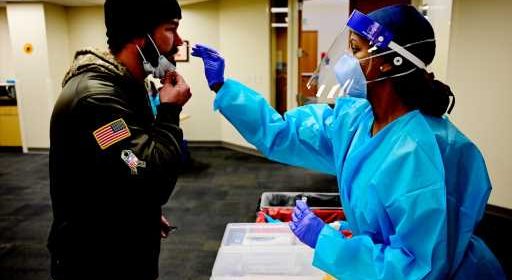Colorado has fewer than 1,000 COVID cases for first time since August

Colorado is averaging fewer than 1,000 new COVID-19 cases per day for the first time since early August and the number of people hospitalized with the virus is falling steadily across the state as the omicron wave continues its sharp retreat.
The Colorado Department of Public Health and Environment reported an average of 936 new cases each day over the last week, down from an average of nearly 14,000 a day during the peak last month of the surge fueled by the virus’s omicron variant.
It’s possible that figure may have been driven down by Monday’s holiday and by snow in parts of the state, though the numbers aren’t significantly out of line with the overall trend in February.
Hospitalizations also dropped to levels last seen in August, when the delta-driven fifth wave was beginning to take hold. As of Tuesday afternoon, 446 people were receiving care for confirmed COVID-19 across the state, down from the omicron peak of 1,676 last month.
Deaths from the virus also appear to be declining steadily, though it’s possible the rate of decline may be slower, since delayed reports are still coming in.
“We are clearly moving into a different phase of COVID in Colorado, and one that is going to be less disruptive,” said Beth Carlton, an associate professor of environmental and occupational health at the Colorado School of Public Health. “Immunity is high and protection against severe disease is very high.”
The positivity rate neared the state’s goal of 5%, with an average of 5.2% of tests coming back positive over the last week — a sharp drop since a high of nearly 30% in mid-January.
While the percentage of tests coming back positive may seem like a less-useful metric, it essentially measures how good a picture the state has of how widespread the virus is.
If the virus isn’t widespread, a large majority of the people getting tested will have allergies, a common cold, or something else causing their symptoms. The higher the percentage that is coming back positive, the more likely it is that the state doesn’t know about a large number of infections, as was the case during the peak of the most recent wave.
A little over 1% of all Coloradans are likely infectious at this point, and new cases will continue to happen during the tail end of the current wave, Carlton said. The difference is that most people are no longer susceptible, at least in the short term, so the virus can’t spread as widely — though crowded settings like nursing homes and prisons may still have outbreaks, she said.
“Those infections shouldn’t spread like wildfire, because the wildfire already happened,” she said.
A report from the state’s COVID-19 modeling team last week estimated about 90% of Colorado’s population will have at least some immunity to the omicron variant, which accounts for essentially all cases in the state at the moment, by the end of February.
If the current trend continues, hospitalizations could fall to levels last seen before the delta surge by March. It’s not clear if they will stabilize there or continue to drop — the lowest point for hospitalizations since COVID-19 arrived in Colorado was actually in June 2020, not last summer.
While the model projects about 80% of people will still be immune to omicron in June, Carlton said the team has “medium to low confidence” around that estimate. At this point, there’s just not enough data to know how quickly immunity will wane, she said. The omicron variant came to the world’s attention in November, so the first people known to have been infected with it are only about three months out from their first exposure.
“We were just starting to understand waning immunity with delta” when omicron took over as the main variant, she said.
Source: Read Full Article